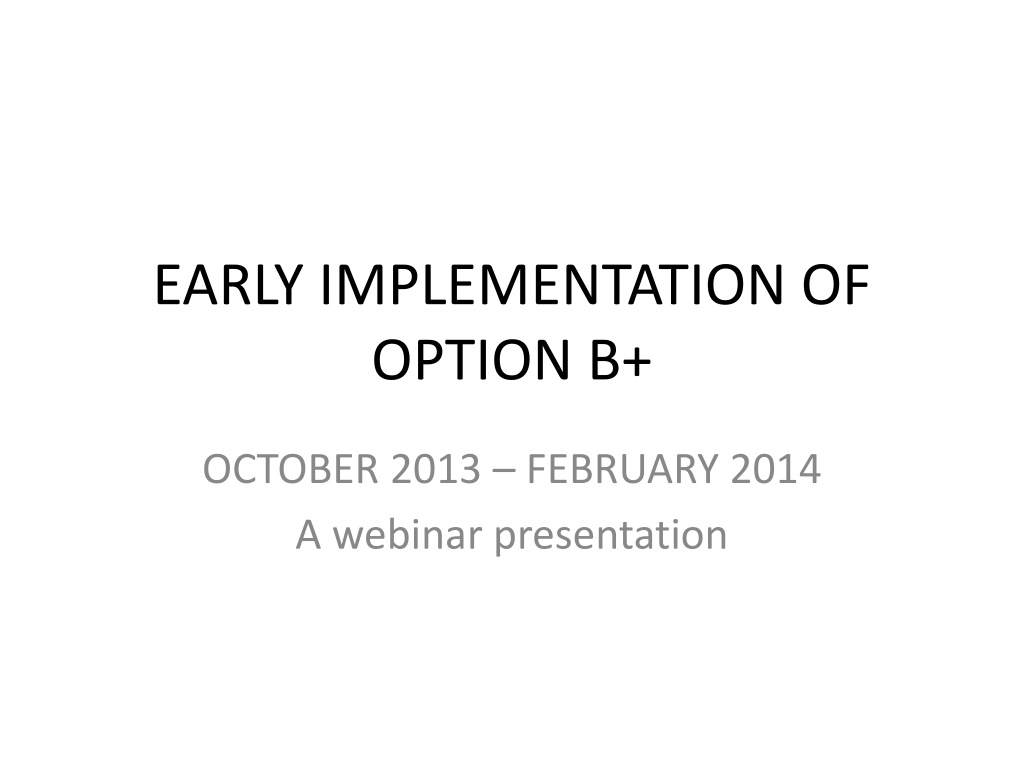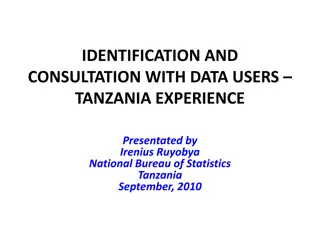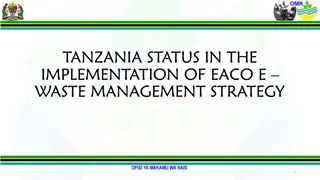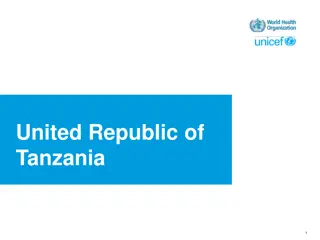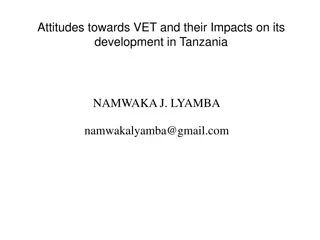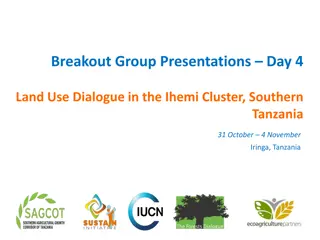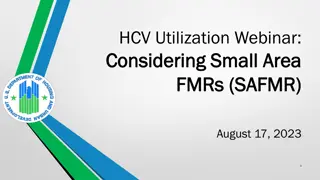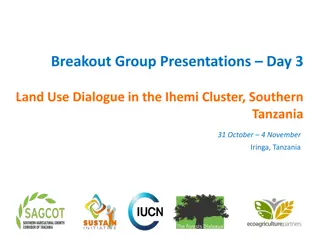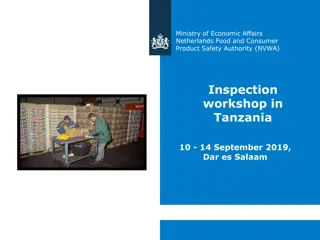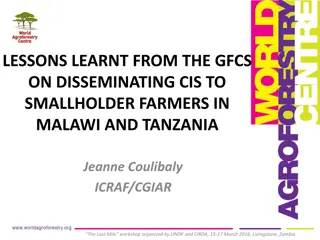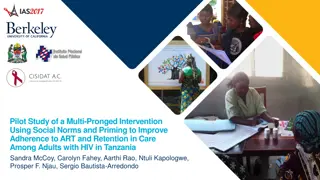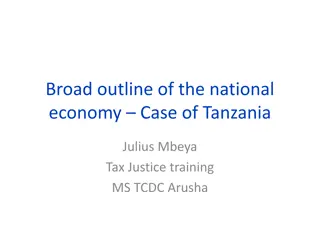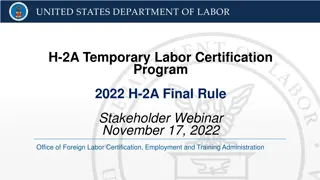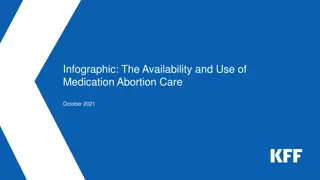Early Implementation of Option B+ in Tanzania: A Webinar Presentation
Explore the early implementation of Option B+ in Tanzania from October 2013 to February 2014 through a detailed webinar presentation. The content covers the country profile, PMTCT strategies, rollout progress, cascade trends, and impact on reducing MTCT rates among HIV-exposed infants. Gain insights into assessment findings, actions taken, and key recommendations for improving PMTCT services in Tanzania.
Download Presentation

Please find below an Image/Link to download the presentation.
The content on the website is provided AS IS for your information and personal use only. It may not be sold, licensed, or shared on other websites without obtaining consent from the author. Download presentation by click this link. If you encounter any issues during the download, it is possible that the publisher has removed the file from their server.
E N D
Presentation Transcript
EARLY IMPLEMENTATION OF OPTION B+ OCTOBER 2013 FEBRUARY 2014 A webinar presentation
Content 1. Country profile 2. PMTCT in Tanzania 3. Option B+; Early implementation assessment findings 4. Actions from assessment findings 5. Recommendations
Country profile 1. Population 45 Million people1 2. 1.4m persons living with HIV (2013)3 3. 98978 pregnant women living with HIV5 4. 5.1% HIV prevalence among adults aged 15-493 5. 5.6% HIV prevalence among pregnant women4 6. Proportion of making at least one ANC visit 97%6 7. Proportion of making at least four ANC visits 43%6 8. Percentage of women with unmet need for family planning 25%6 9. Maternal Mortality Ratio 454/ 100,000 10. Infant Mortality Rates 51/1,000 live births6 11. Syphilis Prevalence among pregnant women 2.4% 1. National Population Census 2012, 2. National projections, 3. Tanzania HIV and Malaria survey 2010, 4. National ANC HIV Surveillance 2011/12, 5. Spectrum projections 2014, 6. Tanzania demographic and Health survey 2010
PMTCT in Tanzania PMTCT is fully integrated in RMNCH 1. FP in HIV context in RMNCH 2. HTC in ANC, L&D and Postnatal 3. ART initiation in ANC, L&D and Postnatal 4. HEID in Postnatal 2000; Pilot 2002 2006 Sd NVP 2006 2010 AZT starting 28th week of GA 2010 2013 Option A 2013 -> Option B+
PMTCT in Tanzania Rollout: By Dec 2014, ~5000 sites had started Option B+ PMTCT site Coverage 6000 5123 5000 Number of PMTCT sites Number of ANC sites offering PMTCT (93%) 4000 3626 3000 2000 Number of PMTCT sites offering B+ 1165 1000 0 0 Baseline (2009) 2011 2012 2013 2014 Year Rollout started in 9 high burden region, in Oct 2013
PMTCT in Tanzania PMTCT cascade trend over time 140000 120000 Estimated number of HIV-positive pregnant women (5.6%) Number of Women 100000 80000 HIV-infected pregnant women who received efficacious ARV (prophylaxis or therapy) to reduce MTCT (73%) 60000 40000 20000 Eligible pregnant women receiving ART for own health (55%) 0 Baseline (2009) 2011 2012 2013 Year A significant increase in # enrolled into ART
PMTCT in Tanzania Trend of New HIV infection rate among HIV exposed infants 40.0 MTCT rates at end of exposure 35.0 30.0 27.4 25.0 20.0 18.3 17.4 15.8 15.0 12.7 10.0 5.0 0.0 Baseline (2009) 2011 2012 2013 2014 Year
EARLY OPTION B+ IMPLEMENTATION ASSESSMENT
Sample description In 7 high burden regions, 1165(66%) of 1756 PMTCT sites started LLAPLA implementation by 4th quarter, 2013 Evaluated 26 sites in 13 districts 11 Hospitals, 9 health Centers, 6 Dispensaries 21 had CTC on site (only 2/6 dispensaries had CTC)
PMTCT DATA QUALITY Data reported closely approximated actual site level performance, with tendency to under- report Crosscheck revealed mean data recording accuracy of 68% (30%-100%) VR=112%
PMTCT cascade, October December 2013, N=26 sites 74% 82%
HIV testing Overall 74% testing coverage 11(42%) of sites reported test kits stock out within the quarter of Oct - Dec In facilities with no stock out; overall testing was 92%, versus 60% in facilities with reported stock out (p<0.01)
ART initiation in RCH Total tested HIV positive/known Total Initiated (Oct-Dec) Retained at one Level Hospital month 627 547 779 Health center Dispensary Overall 162 93 802 330 121 1230 280 96 1003 Total initiated includes 1. Newly Diagnosed women 2. Transitioning from AZT to TLE 3. Transfers of pregnant and breastfeeding women from CTC to RCH
ART initiation in RCH Large number of breastfeeding and pregnant women currently on ART transitioning to new TLE regimen Unanticipated, leading to TLE stock shortage Competition for TLE between RCH and ART clinics Complete TLE stockout; switching to alternative regimens 4 (15%) sites reported TLE Stock out
Commodity Management Facility staff asked to demonstrate how to order commodities and graded as correct or incorrect 77% correctly demonstrated ordering HIV test kits 88% for ARV ordering Lower knowledge of protocol associated with reported stockout in past months Sites with TK stockout, 73% vs. 81% demonstrated correct protocol Sites with TLE stockout, 75% vs. 91% correct protocol
Site visits observations Site staff were not aware of poor retention There was little skills in chronic care clinic management, (no appointment and follow-up system) Week community linkage (Home based care services is not integrated into RCH) Some sites with good retention reported using cellphone reminder Stock outs were not uncommon even before rollout of B+ RTKs TLE, but other ARVs were available
Capacity and space Observation Limited space in RCH for confidential ART services Fewer staffs against large service portfolio ANC, Immunization, FP, PMTCT-LLAPLA Untapped capacity and resources at ART clinics coexisting with RCHs Limited space and high workload domino effect Inadequate adherence assessment, counseling and support Shortage of current data tools Many data errors noted, due to inadequate understanding of ART data and patient management
Key Findings 1. LLAPLA was successfully rolled-out as planned 2. Data issues threatens program s ability to monitor performance a. Retention b. Accuracy of other metrics 3. HIV commodities Stock stability was promising a. TLE stock levels were not optimum during rollout onset; Stabilized later b. RTKs stock levels have ben in emergency levels, without drastic stockout 4. Staff capacity and space for quality care in RCH clinics remain desired a. Retention issues related to skills, data and inadequate community linkage b. Space and HR shortage compromise privacy, and quality time for care
Actions from Findings 1. Redistribution of TLE from overstocked, to under stocked/stocked out facilities Emergency supply of RTKs Addressing data issues and overall performance; a. Starting scoring system, and incorporation of PMTCT indicators into RMNCH score card b. PMTCT-RMNCH focused DQA c. Designing Cohort monitoring for Mother-Baby pair d. Developing response system focusing on i. Commodity availability ii. Retention iii. HEID iv. Quality of HTC v. Data quality e. Adapting appointment and tracking systems for chronic care 2. 3.
Recommendations 1. Considering data requirement and appropriate adjustment to meet M&E needs (include continuous data quality improvement) a. Data needs b. Quality 2. Consider Logistic systems, anticipated and unanticipated events a. Smart push for consumables b. Proper Commodity management (chronic care needs) 3. Capacity and space a. Tap into existing ART clinics staff skills in chronic care b. Task shifting, Nurses focus on clinical care c. Expand clinic space, and manage appointments d. Enforce quality improvement
Recommendations 4. Develop/implement emergency response system especially in the early phase d. Commodity stock stability e. Data quality f. Retention monitoring g. Quality of HTC
Acknowledgement 1. Regional Teams in regions involved 2. USG and UNICEF Tanzania 3. IATT-UNICEF New York 4. MoHSW PMTCT program staff
